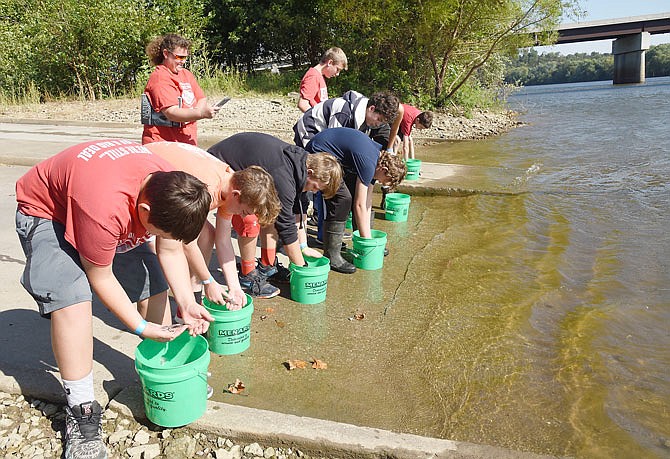Releasing dinosaurs is not what a group of Mid-Missouri students did Friday, but the students did get to work with a species that's outlived the dinosaurs, and the individual animals could outlive most anyone present.
"Prehistoric" is the word Travis Moore said probably gets used the most to describe lake sturgeon.
Moore is a fisheries management biologist with the Missouri Department of Conservation in Hannibal.
"Some folks say they look like a dinosaur," he said of lake sturgeon. The fish having a spiky, somewhat shark-like appearance, bony plates instead of scales, toothless mouths on the underside of their bodies and reflective eyes that perform well in low-light conditions.
On Friday, students from the Osage R-2 and Harrisburg R-8 school districts helped stock the Osage River with lake sturgeon. The Mid-Missouri students filled buckets with river water and then carried sturgeon in the buckets from a fishery truck down the Mari-Osa River Access boat ramp to the river's edge.
Carson Shockley, 11, from Osage R-2, said, "Releasing them, I could just feel them - I think they're happy." Shockley said he's done catch-and-release fishing, but he had not previously handled lake sturgeon.
Emily Porter said Friday's event was part of the MDC's "Discover Nature Schools" conservation curriculum program, available for students in preschool through 12th grade - and more specifically, the "Nature Unhooked" curriculum unit for sixth through eighth grades, unveiled in the last year, that focuses on aquatic ecosystems.
Porter is a conservation educator with the MDC's Central Regional Office and Conservation Research Center in Columbia.
"From kindergarten to 12th grade, (the program offers) a transportation reimbursement grant," that lets schools travel to a field experience, where students "are able to work on field investigations and scientific evidence reasoning, and trying to find out how they can really fit into that career as a scientist," she said.
Friday's group of about 78 students - 36 sixth-graders from Osage R-2 and 42 eighth-graders from Harrisburg - learned at different stations: how telemetry equipment is used to track fish that have been microchipped; how to remove a fish from a net and measure and tag it; and how to tell sturgeon apart from other fish such as walleye, Fathead minnows and orangespotted sunfish.
Travis Moore, a fisheries management biologist with the MDC in Hannibal, said lake sturgeon are endangered because of over-fishing in the late 1800s and early 1900s.
Moore described how the bottom-feeding lake sturgeon - the second-largest fish in the state - can live a long time, more than 100 years. The fish can grow to weigh more than 200 pounds and measure 8 feet in length.
While the non-aggressive lake sturgeon's big adult size makes the fish immune to predators - once they're old enough to no longer be prey for crayfish, Moore said - the fish's long life cycles make the species vulnerable, taking a long time to recover from hits to the population.
Moore said, "Commercial fishermen (at the turn of the 20th century) didn't see much use for them, and they'd literally pull them out of the river, put them up on shore and dry them out - they would burn them in the wintertime for firewood. That's how little value they actually put in that fish back at the time, so it didn't take very long for them to over-fish them."
He said the fish don't reach adulthood until their 20s, and even once they reach that first spawning age, males only spawn every one to three years, and females only every four to seven years.
Moore said the first stocking of lake sturgeon in Missouri began in the mid-1980s, and it's only just in the present that the first generations of fish are reaching adulthood.
He said about 50,000-60,000 sturgeon were stocked this year - "the last 500 are literally on that truck" that was used Friday.
Moore said the goal of stocking is to have a self-sustaining population of the fish in the wild, which means stocking until there is enough spawning-capable adults in the wild each year.
Because lake sturgeon are endangered, fishers - especially catfishers, who are more likely to catch the also bottom-feeding lake sturgeon - have to put any lake sturgeon back that are caught, though Moore said it's OK to take a quick picture before that, but the quicker the better for a stressed fish out of water.
He said Friday's education event is the first of its kind for lake sturgeon, though the MDC is also looking into having public stocking events.
Porter said the education event with lake sturgeon will always be done primarily this time of year, based on the sturgeons' size and when they're able to be released.
Moore said it's important to build a relationship between students, rivers and the lake sturgeon; "Because that fish can live to be more than 100 years old, the fish that these kids are stocking now, as they get older, their kids and their grandkids may be out here fishing for that species, and so they'll be able to talk to their family about coming down here and actually stocking one of the fish themselves."

